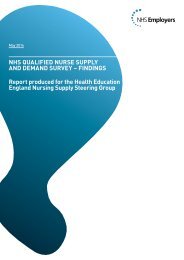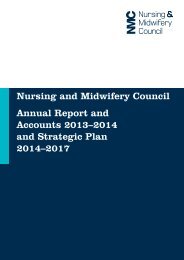Journal_1_2014_final_WEB
Journal_1_2014_final_WEB
Journal_1_2014_final_WEB
You also want an ePaper? Increase the reach of your titles
YUMPU automatically turns print PDFs into web optimized ePapers that Google loves.
Science, Practice and Education<br />
The occurrence of highly virulent organisms, such as<br />
Pseudomonas aeruginosa, is underestimated by conventional<br />
culturing methods. 8 Dowd et al. used genetic methods<br />
to demonstrate that obligate anaerobes are present in 62%<br />
of chronic ulcers. This study concluded that bacterial cultures<br />
from ulcers rarely reflect the true bacterial population<br />
of the ulcer.<br />
There are several indications that conventional microbiological<br />
methods reveal only organisms that grow<br />
relatively rapidly and are simple to detect in the culture<br />
medium. Importantly, biofilm cannot be detected by these<br />
methods. 18 Therefore, better microbiological methods are<br />
needed to understand the bacterial environment of the<br />
ulcer. In clinical practice, samples from ulcers should be<br />
taken only in cases in which there is an indication for<br />
infection that could benefit from antibiotic therapy. Indications<br />
for systemic antibiotic treatment are shown in<br />
Table 2. As outlined in Table 2, there is a low threshold<br />
for administering antibiotics in patients with diabetic foot<br />
ulcers and in patients who are on immunosuppressive<br />
medications. However, an ulcer will never be sterilized by<br />
antibiotics. The assessment of the results provided by the<br />
microbiologist should focus on the correct choice of antibiotic<br />
that reduces the risk for resistant strains to develop.<br />
Systematic reviews have not shown that antibiotics are an<br />
effective treatment for chronic ulcers. 19,20 Clinical experience<br />
demonstrates that ulcers treated with antibiotics<br />
may improve over brief periods, but deteriorate after the<br />
antibiotic has been withdrawn. The results of the current<br />
study suggest that 13.3% of patients received repeated<br />
“cures” with antibiotics. However, the assumption based<br />
on current evidence is that, although the bacterial flora<br />
within an ulcer may be reduced over a brief period during<br />
antibiotic treatment, the polymicrobial flora return when<br />
the medication is stopped. 8<br />
Table 2. Indications for use of antibiotic therapy in ulcer infections<br />
n At least 3 of the following clinical signs of infection:<br />
– Local heat<br />
– Redness that spreads more than 2 cm around the ulcer<br />
– Pain<br />
– Swelling<br />
n Contact with bone (osteomyelitis/osteitis)<br />
n Progression of the ulcer with the formation of satellite ulcers<br />
n Clinical signs of infection by streptococci group A (erysipelas)<br />
n Diabetic foot ulcers<br />
n Patients with immunosuppression<br />
The excess use of antibiotics in ulcer patients was studied<br />
as early as 1998 by Tammelin et al. in Sweden. Their investigation<br />
showed that 60.1% of patients had received<br />
an antibiotic treatment over an observation period of 6<br />
months. Their investigation also found resistant Staphylococcus<br />
aureus in 12.5% of these cases. 2 The risk of developing<br />
methicillin resistance increases with the administration<br />
of systematic antimicrobial therapy 7.<br />
Local antibiotic treatment of ulcers is not recommended<br />
because of the rapid development of resistance and<br />
the risk of allergic reactions. Nevertheless, the results of<br />
the current study indicate that local antibiotic treatment<br />
is widely prescribed. Several studies have suggested that<br />
products containing silver, honey, or iodine are recommended<br />
if local antibiotic treatment is necessary.<br />
7,19,21, 22<br />
Secretions from blowfly larvae have also been shown to kill<br />
bacteria. 23 These larvae have also been used to eradicate<br />
methicillin-resistant Staphylococcus aureus (MRSA) from<br />
ulcers 24. Ulcer rinsing agents or bandages that contain<br />
betaine and polyhexamide have also been shown to be<br />
effective treatments to reduce bacteria in ulcers. 25,26<br />
A total of 80-90% of antibiotic use takes place outside<br />
of the hospital. 27 An English study of antibiotic use<br />
among ulcer patients reported that more than 2 out of 3<br />
patients with non-healing ulcers received prescriptions<br />
for antibiotics from their family doctor over the course<br />
of 1 year. For comparison, only 1 out of 3 patients with<br />
other diagnoses (not related to non-healing wounds) were<br />
prescribed antibiotics. 28 This study also showed that antibiotics<br />
were administered over a longer period of time in<br />
ulcer patients compared with patients without ulcers. The<br />
practice of antibiotic prescription therefore seems to reflect<br />
uncertainty among physicians about how to treat ulcers.<br />
Updated Norwegian guidelines on the use of antibiotics<br />
can be found in both hospitals and primary health services.<br />
29,30,31,32 An article by Berild and Haug confirms that<br />
chronic ulcers of the legs are most frequently colonized<br />
by non-dangerous bacterial flora and that good local ulcer<br />
treatment without antibiotics is sufficient. The guidelines<br />
suggest that caution should be taken with respect to the<br />
use of antibiotics in ulcers, except in diabetic ulcers of<br />
the foot or cases of demonstrated streptococci, and indicate<br />
that topical antibiotics are contraindicated. 30 Other<br />
guidelines on the use of antibiotics in primary health services<br />
describe conditions such as erysipelas, diabetic foot<br />
ulcers, and impetigo as examples of skin and soft tissue<br />
infections. These guidelines also caution against the use<br />
of antibiotics. 29,31,32 However, these publications do not<br />
mention guidelines for common types of chronic ulcers,<br />
such as venous leg ulcers, pressure ulcers, and postopera-<br />
<br />
EWMA <strong>Journal</strong> <strong>2014</strong> vol 14 no 1 21




